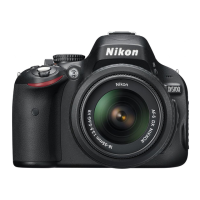40
z
3 Choose a focus mode.
Highlight a focus mode and press J.
To return
to shooting mode, press the shutter-release
button halfway.
A Predictive Focus Tracking
In AF-C mode or when continuous-servo autofocus is selected in AF-A mode, the camera will
initiate predictive focus tracking if the subject moves toward or away from the camera while
the shutter-release button is pressed halfway.
This allows the camera to track focus while
attempting to predict where the subject will be when the shutter is released.
D Continuous-servo Autofocus
When Focus is selected for Custom Setting a1 (AF-C priority selection; 0 158) and the
camera is in AF-C mode or continuous-servo autofocus is selected in AF-A mode, the camera
gives higher priority to focus response (has a wider focus range) than in AF-S mode, and the
shutter may be released before the in-focus indicator is displayed.
A Getting Good Results with Autofocus
Autofocus does not perform well under the conditions listed below.
The shutter release may
be disabled if the camera is unable to focus under these conditions, or the in-focus indicator
(I) may be displayed and the camera may sound a beep, allowing the shutter to be released
even when the subject is not in focus.
In these cases, focus manually (0 45) or use focus lock
(0 44) to focus on another subject at the same distance and then recompose the
photograph.
There is little or no contrast
between the subject and the
background.
Example: Subject is the same
color as the background.
The focus point contains
areas of sharply contrasting
brightness.
Example: Subject is half in
the shade.
The focus point contains
objects at different distances
from the camera.
Example: Subject is inside a
cage.
Background objects appear
larger than the subject.
Example: A building is in the
frame behind the subject.
The subject is dominated by
regular geometric patterns.
Example: Blinds or a row of
windows in a skyscraper.
The subject contains many
fine details.
Example: A field of flowers or
other subjects that are
small or lack variation in
brightness.

